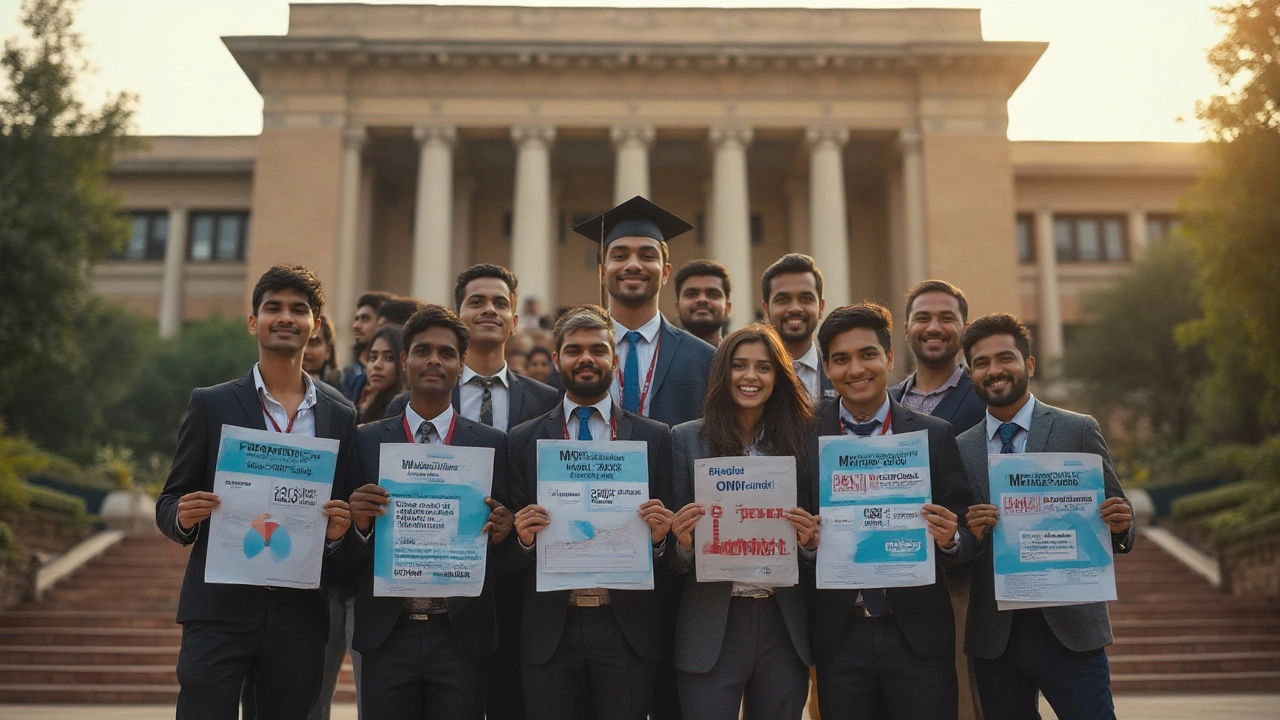Which IIT Branch is Best in India? Top Options for JEE Aspirants in 2025
 Jul, 29 2025
Jul, 29 2025
Picture this: it’s 1995, and Computer Science is just starting to bloom at IITs. Fast-forward to today—every parent with a JEE-obsessed teen is asking the same question at dinner: Which is the No 1 IIT branch in India? Every year, around 1.5 million candidates chase a spot at one of the Indian Institutes of Technology. Seats are limited. Pressure is sky-high. Yet, after all the sweat and coaching hours, the real puzzle is not just making it into an IIT—but grabbing that golden branch.
The Race for the Top: Why Branch Matters More Than Ever
There’s a reason branch preferences steal the spotlight right after JEE results. Your branch is more than your “major”—it’s the ticket that opens specific doors in tech, entrepreneurship, academia, or even global leadership. For years, Computer Science and Engineering (CSE) has ruled the IIT charts. Try asking a batch of freshers at IIT Bombay or Delhi why they chose CSE, and nearly everyone talks about placement packages, fame, and cool tech.
CSE at old IITs (like Bombay, Delhi, Kanpur, Kharagpur, and Madras) fills up fastest in the first few rounds. Just check the JoSAA closing ranks—every year, the cut-offs for CSE at these campuses are the lowest (meaning most competitive). Last year, the closing rank for CSE at IIT Bombay was AIR 68 for general category—meaning just the top 68 kids in the entire country could grab it. Insane, right?
But it’s not only about placements. Think of the impact: graduates from these branches run Unicorn startups, write code powering billions, and lead teams in Silicon Valley. Did you know that Sundar Pichai (yes, the Google CEO) graduated from Metallurgical Engineering at IIT Kharagpur? Yet, everyone still fights for CSE. Branch equals brand. Brand equals opportunity.
Now, a tip that’s rarely talked about: while you’re busy listing CSE in your JoSAA choices, don’t ignore related branches like Electrical Engineering or Mathematics and Computing. Hiring managers and grad schools love interdisciplinary backgrounds. If you’re strategic, picking Electrical at the right IIT can sometimes outweigh CSE at a younger or less famous IIT.
Breaking Down the Top Branches: CSE, EE, Mech, and More
Let’s get specific. The usual suspects—CSE, Electrical Engineering, and Mechanical Engineering—dominate the minds of JEE aspirants.
No 1 IIT branch? Statistically, it’s almost always CSE, but context matters.
- Computer Science and Engineering (CSE): Bleeding-edge tech, fat offer letters, internships at Google, Microsoft, Oracle. You learn from the best, create code that scales globally, and join a connected network for life. At IIT Bombay, average salary for CSE in the 2024 batch was ₹47 LPA (lakhs per annum), with top offers zooming above ₹1 crore. Overseas roles? You bet. Big names like Airbnb, Jane Street, Google—they all short-list heavily from this department.
- Electrical Engineering (EE): If you’re curious about AI, chips, hardware, and even financial engineering, EE gives you serious options. Many EE grads switch to software or analytics, and companies don’t mind—because the branch trains you in logic and systems design.
- Mechanical Engineering: Still evergreen. But let’s be real—the pay and placements here can’t always match CSE and EE. Mechanical is favored by those interested in core engineering, robotics, and research. Still, top global manufacturing and automation companies come hunting for talent.
- Mathematics and Computing (M&C), Engineering Physics, Chemical Engineering: These are the rising stars. Especially at IIT Delhi and Kanpur, M&C has huge value. The reason? It blends solid math with coding, prepping you for data science and fintech roles.
For a clearer picture, here’s a quick stat snapshot from 2024 placements at five premier IITs:
| Branch | IIT Bombay Avg. Salary (₹LPA) | IIT Delhi Avg. Salary (₹LPA) | Highest Offer (₹LPA) |
|---|---|---|---|
| CSE | 47 | 46.2 | 120 |
| EE | 32.5 | 33 | 82 |
| Mech | 27.6 | 26.8 | 54 |
| M&C | 38 | 39.1 | 95 |
Pretty eye-opening, right? Notice how M&C is catching up fast in salary and placement stats. Also, think about location—being in Mumbai or Delhi means more exposure to industry interactions, start-ups, and extra-curriculars.

IIT: Not All Campuses Are Equal
Everyone talks about the top branches, but the campus makes a huge difference. The five "older" IITs—Bombay, Delhi, Kanpur, Kharagpur, and Madras—carry a heavy brand weight. Recruiters know these places. Alumni are everywhere. The student bodies are diverse, with more opportunities for research and international exposure.
The "newer" IITs—like IIT Hyderabad, IIT Gandhinagar, or IIT Indore—offer excellent faculty, snazzy infrastructure, and sometimes smaller batch sizes (which can be a pro). But the legacy and strong recruiter relationships still tip the scales in favor of the older campuses, especially for high-paying software roles.
Here’s something you probably haven’t heard: the competition for internships and placements is so fierce at old IITs, some top scorers in new IITs get better leadership roles and face less crowding for the best companies on campus. I’ve seen bright students carve out bold, ambitious careers from these campuses—by starting their own ventures, researching abroad, or switching to finance or consulting.
Here’s me being a dad: if my son Ishaan wants to do something different—not just coding or consulting—I’d tell him to look at the culture and opportunities at each IIT, not just the salary numbers or the branch brand. It’s that mix of location, alumni network, and campus culture that grows your confidence and world view.
IIT Madras, for example, won QS World University Ranking for the top institute in India in 2024, beating even the IIMs and AIIMS! The faculty there are known for pushing students to innovate beyond marks and placements. IIT Kharagpur is famous for its sprawling campus and interdisciplinary research, while IIT Delhi sits in the heart of India’s tech and consulting ecosystem. Tiny choices make a big difference.
Dr. P.V. Indiresan, a noted IIT Director, once said,
“Your branch can open the first door, but your outlook opens the windows.”
There are students who join Civil or Aerospace, discover a love for analytics or entrepreneurship, and end up leading in areas no one predicted at admission.
How to Pick the Right IIT and Branch for You
Here’s where things get personal. Ignore the pressure of what the "toppers" are picking and tune into your own interests, dreams, and what excites you beyond rank lists. Yes, the glamour of Computer Science can’t be denied, but not everyone wants to spend days in front of a code editor or crunching data. If you see yourself building bridges or high-speed trains, or leading oil companies, Civil and Chemical branches are loaded with opportunities.
When you’re juggling choices, use a brutal, honest checklist:
- Cut-Offs and Ranks Matter: Always check the previous year’s closing ranks on the JoSAA portal. This tells you real demand—and how you stack up.
- Placements and Packages: Go beyond average salaries. Look at the list of companies coming to campus, the types of roles, and whether alumni are breaking into new fields like AI, fintech, or consulting.
- Faculty and Labs: Explore which IITs have research centers or active clubs in areas you like—robotics, AI, entrepreneurship, and more.
- Alumni Network: This is underrated. LinkedIn-stalk a few seniors or reach out in online forums. See where people from your dream branch-cum-IIT are today.
- Location, Location: A metro campus equals more internships, company visits, and the buzz of start-up life.
- What Do You Value Most? If you’re driven by intellectual curiosity, choose a branch with strong faculty and research. If money is key, CSE wins. If work-life balance is your jam, look at campus culture, extra-curriculars, and workload.
Here’s a nugget from an IIT alumnus who ditched CSE for Mechanical and loved it:
“The peer group at the top IITs pushes you. Doesn’t matter which branch—if you’re hungry, you’ll find a way. My time in the workshops, not the classrooms, made me a hustler.”
Talk to seniors or recent passouts—they’ll give you the good, the bad, and the honest. Join the Telegram, Discord, or Reddit channels and lurk for a week. Patterns will jump out: Which branches have the happiest students? Where are the most startups? Who gets into IIMs and Ivy League grad schools?
One more hard-earned tip: if you’re not sure of your interests now (trust me, at 17 or 18, I didn’t really know either), lean towards branches that let you maintain flexibility. CSE, EE, and M&C often have electives from across the departments, letting you “test drive” new areas in your second or third year.
Don’t get trapped by what’s trendy. Sometimes, the most successful IITians are those who took risks—forged their own paths in niche fields and built bold careers even outside their original branches.
At the end, the "No 1 IIT branch" question can only be answered in the context of YOU—your spark, your ambition, and the future you want. One size does not fit all, and sometimes, the second or third choice on your JoSAA list could end up being the one that changes your life.